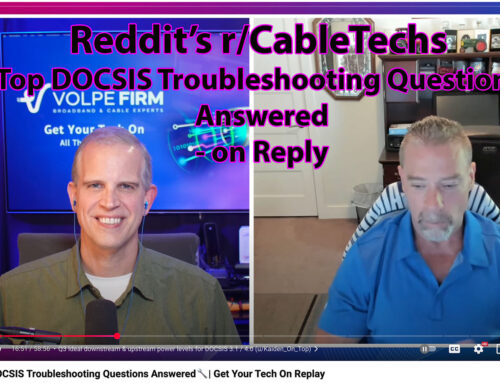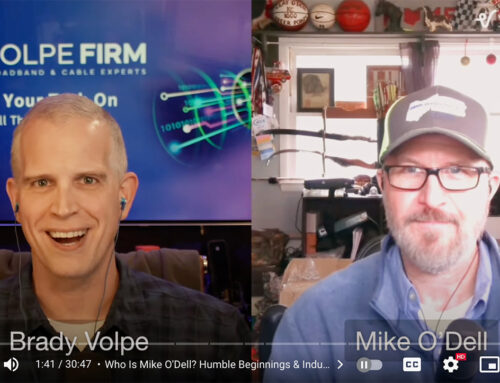The full duplex (FDX) DOCSIS extension to the DOCSIS 3.1 specification has been finalized in Annex J of that spec. What does this mean? A major goal of FDX DOCSIS is the ability to deliver symmetrical data speeds up to 10 Gbps in hybrid fiber/coax (HFC) networks. How does it work? I covered some of this in the Spring 2018 issue of Broadband Library on FDX which you can find here: https://broadbandlibrary.com/full-duplex-docsis/ and will further explore the benefits of FDX now.
Why FDX Now?
Why am I focusing on FDX when everyone else is talking about DOCSIS 3.1 success stories? Because FDX is actively being looked at now, it is also something that is required to support subscriber demand, and the earlier we as an industry begin understanding its pros and cons, the better prepared we will be to deploy it when the time is right.
Let’s consider the history of previous DOCSIS versions by looking at the DOCSIS historical roadmap.

In each version of DOCSIS shown in Figure 1, the publication date on the bottom row is displayed. Once CableLabs releases the specification, there is a delay of typically a couple of years between publication release date and when cable operators are able to go mainstream. Let’s take a look at the most recent example, which is DOCSIS 3.1. The publication release date for DOCSIS 3.1 was 2013.
On February 2nd, 2016 a press release from Comcast read as follows:
“Comcast announced it had successfully installed its first DOCSIS 3.1 modem in Philadelphia, and one was installed in Atlanta a few days later. DOCSIS 3.1 technology delivers gigabit Internet speeds using the connections already in customers’ homes.” — Source: https://corporate.comcast.com/news-information
This was nearly three years from publication of the DOCSIS 3.1 specification. Still today we see regular press releases from many cable operators announcing the availability of DOCSIS 3.1 service in new markets. DOCSIS 3.1 is still in the early deployment stage by many operators, with most operators initially deploying DOCSIS 3.1 in the downstream and planning for upstream deployment later.
Where does this leave us with FDX deployments?
During my March podcast with Larry Wolcott of Comcast, he indicated a great deal of his time in 2019 will be spent looking at FDX. Should we apply the same time guidance to FDX as DOCSIS 3.1, we can estimate that FDX may see early production deployments in 2020. Perhaps this would be followed by mass adoption in 2022 if history holds true. We have some time ahead of us, but this technology is not far off, and we should examine its benefits now.
One of DOCSIS 3.1’s goals was scalability to 10+ Gbps in the downstream and 1+ Gbps in the upstream. Most operators are currently using DOCSIS 3.1 to support gigabit-class services. However, we must look towards the future and hungry data-eating subscribers. Looking at any number of trending predictions, subscribers are not slowing their demand for data. Figure 2 is just one of the many predictors from Cisco’s yearly Visual Networking Index (VNI) report. This chart shows a 26% increase year-over-year on just over-the-top video (OTT). From 2019 to 2022 OTT video will double on our networks. That is an increase of 200 exabytes per month to 400 exabytes per month in just four years. This is not including other sources of Internet traffic such as virtual reality (VR), augmented reality (AR), Internet of Things (IoT) and technologies we have yet to witness.
These data drivers will force operators to invest in their cable plants for FDX DOCSIS or fiber. Which is a better solution depends on many variables. It is important to understand that in many cases one is not a clear winner over the other. Geography, demographics and business decisions all come into play. What is being offered are options to ensure that the cable operator has a viable business solution to provide the best possible solution to the subscriber at the best possible price point. In economic terms we look at this as supply vs. demand curves.
More Options for Operators
Recently I had the pleasure to speak on this topic at the Society for Broadband Professionals (https://www.thescte.eu) in Birmingham, UK for their Spring Lecture Series (http://bit.ly/scteFDX). A key challenge in the UK and Europe is also not different than one faced in North America. In order to realize the benefits of FDX DOCSIS all diplex filters must be removed. In order to do this the HFC network becomes a node + 0 architecture. In a suburban subdivision this can be achieved with reasonable effort and contractors. In an urban area such as New York City or Los Angeles, this becomes much more challenging.
What to do in the face of these challenges? More options to overcome them!
• Vendors are developing FDX amplifiers. FDX amplifiers are reportedly able to extend FDX networks beyond node + 0 to as many as node + 4 deep. Though these full duplex amplifiers are still in the early stages and will also require echo cancellation, they would be a game changer in deploying FDX DOCSIS in markets one would have previously thought not possible.
• 10G Ethernet Overlay Networks — Another interesting technology, which I have covered before on the Volpe Firm Podcasts here https://youtu.be/6lqPQpu8dRk, is 10G Ethernet over the HFC plant. In this scenario, broadband QAM channels placed above existing analog and SC-QAM channels enable the delivery of an unimpaired 10 Gbps Ethernet pipe to either a DOCSIS 3.1 or FDX DOCSIS node. The value to the operator is that an existing HFC cascade can be utilized to deliver existing services with a 10G Ethernet overlay. FDX nodes can be placed anywhere in the network where the 10G Ethernet overlay exists. The FDX nodes connect directly to the 10G Ethernet overlay and then distribute 10 Gbps service to subscribers over coax as if it were node + 0 from the FDX node. However, in this case the FDX node can be attached to multiple amplifiers in a cascade but is still being provided a clean 10 Gbps data signal from 10G Ethernet overlay network. Very cool!
• A third technology being used by at least one major European operator to reach subscribers in remote locations is point-to-point wireless in the 60 GHz band to transport bi-directional 10 Gbps Ethernet to a remote DOCSIS 3.1 node. Their current implementation is said to allow for a maximum distance of 3 km with no degradation of signal during rain, wind or snow events. The result is wireless 10 Gbps to the DOCSIS 3.1 node in areas where running coax or fiber would be either physically or financially cost prohibitive.
The conclusion of these options, similar to DOCSIS 3.1 and FDX DOCSIS, is that providing innovative solutions is part of the cable industry DNA. One day we may likely be all fiber or even all wireless, but that day is far from now.
FDX and PNM
DOCSIS and proactive network maintenance (PNM) have now come full circle. First there was DOCSIS. Then an initiative was started called PNM in which we identified ways to mine data from the cable modem and CMTS in order to identify RF plant impairments. Later, in DOCSIS 3.1, PNM was found to be so valuable that PNM specific parameters were integrated into the DOCSIS 3.1 specification. Now, in FDX DOCSIS, PNM will be used as part of the methodology by which FDX nodes are able to identify interference between one modem and another. This is a process called sounding, which was briefly touched on in my previous article https://broadbandlibrary.com/full-duplex-docsis/.
What’s new is that the FDX node is something that can be envisioned as a PNM brain. The FDX node will be performing significant echo cancellation for many reflected signals by high powered transmission in the downstream as well as signals transmitted by the FDX modems. As part of echo cancellation, the FDX node will be aware of every micro-reflection that the FDX node cancels. This will provide unapparelled visibility into the RF plant. The FDX node will be able to determine plant impairments within nanosecond accuracy, where 1.2 ns = 1 foot of distance in the coax. Having this type of visibility into the plant after the fiber node will allow us to determine the location of mainline taps and splitters to within one foot or less accuracy. Further, it will allow us to identify splices in coax, bad or loose connectors, corrosion, damaged cable and more — all within a one foot estimated accuracy.
There are many anticipated challenges with deploying FDX, however, PNM and the visibility that is anticipated with it will be crucial in overcoming the challenges in FDX deployment and ensuring its success.
Finish reading at Broadband Library





Leave a Reply